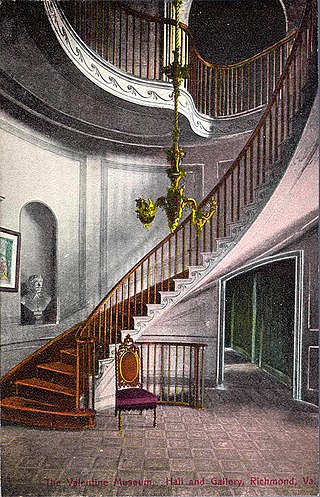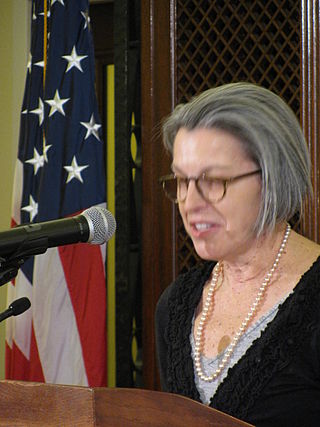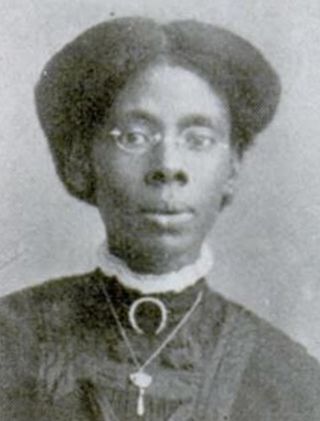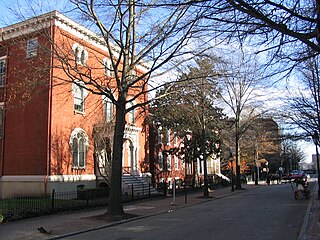Related Research Articles

Virginia Commonwealth University (VCU) is a public research university in Richmond, Virginia. VCU was founded in 1838 as the medical department of Hampden–Sydney College, becoming the Medical College of Virginia in 1854. In 1968, the Virginia General Assembly merged MCV with the Richmond Professional Institute, founded in 1917, to create Virginia Commonwealth University. In 2022, more than 28,000 students pursued 217 degree and certificate programs through VCU's 11 schools and three colleges. The VCU Health System supports the university's health care education, research, and patient care mission.
Church Hill, also known as the St. John's Church Historic District, is an Old and Historic District in Richmond, Virginia. This district encompasses the original land plat of the city of Richmond. Church Hill is the eastern terminus of Broad Street, a major east-west thoroughfare in the Richmond metropolitan area. The name Church Hill is often used to describe both the specific historic district and the larger general area in the East End encompassing other neighborhoods such as Union Hill, Chimborazo, Fairmount, Peter Paul, Woodville, etc.

Maymont is a 100-acre Victorian estate and public park in Richmond, Virginia. It contains Maymont Mansion, now a historic house museum, an arboretum, formal gardens, a carriage collection, native wildlife exhibits, a nature center, and Children's Farm.
This article is about the many neighborhoods and districts in the Greater Richmond, Virginia area. Note that this article is an attempt to be inclusive of the broader definitions of the areas which are often considered part of the Greater Richmond Region, based on their urban or suburban character and nature, rather than by strictly political boundaries.

James Henry Dooley was a Virginia lawyer, business leader, politician, and philanthropist based in Richmond during Reconstruction and the Gilded Age. He represented Richmond in the Virginia House of Delegates for three terms.

The Poe Museum or the Edgar Allan Poe Museum, is a museum located in the Shockoe Bottom neighborhood of Richmond, Virginia, United States, dedicated to American writer Edgar Allan Poe. Though Poe never lived in the building, it serves to commemorate his time living in Richmond. The museum holds one of the world's largest collections of original manuscripts, letters, first editions, memorabilia and personal belongings. The museum also provides an overview of early 19th century Richmond, where Poe lived and worked. The museum features the life and career of Poe by documenting his accomplishments with pictures, relics, and verse, and focusing on his many years in Richmond.

The Valentine is a museum in Richmond, Virginia dedicated to collecting, preserving and interpreting Richmond's history. Founded by Mann S. Valentine II 1898, it was the first museum in Richmond.

Branch House in Richmond, Virginia, was designed in 1916 by the firm of John Russell Pope as a private residence of financier John Kerr Branch (1865–1930) and his wife Beulah Gould Branch (1860–1952).

Claudia Emerson was an American poet. She won the 2006 Pulitzer Prize for her poetry collection Late Wife, and was named the Poet Laureate of Virginia by Governor Tim Kaine in 2008.

Virginia Estelle Randolph was an American educator in Henrico County, Virginia. She was named the United States' first "Jeanes Supervising Industrial Teacher" by her Superintendent of Schools, Jackson Davis, and she led a program funded by the Jeanes Foundation to upgrade vocational training throughout the U.S. South as her career progressed. Her work is widely associated with vocational education. Two schools of the Henrico County Public Schools system were named in her honor and in 2009 Randolph was posthumously honored by the Library of Virginia as one of their "Virginia Women in History" for her career and contributions to education.
Historic Richmond Foundation was founded in 1956 by Elisabeth Scott Bocock, Louise Catterall, Mary Wingfield Scott, Dr. Wyndham B. Blanton, and others in order to save the Church Hill area surrounding St. John's Church. The mission of Historic Richmond is "to shape the future of Richmond by preserving our distinctive historic character, sparking revitalization and championing our important architectural legacy".

Court End is a neighborhood in Richmond, Virginia, that sits to the north of the Capitol Square and East Broad Street. It developed in the Federal era, after Virginia's capital moved from Williamsburg.
Anne Firor Scott was an American historian, specializing in the history of women and of the South.

Scott House, also known as Frederic W. Scott House and Scott-Bocock House, is a historic home located in Richmond, Virginia and is owned by Virginia Commonwealth University as the University's alumni house. The first floor of the historic house is available for university, community and corporate events. Many affairs — including university and alumni receptions and retreats — have occurred at the Scott House since its doors opened in the fall of 2004.

Theresa Pollak was an American artist and art educator born in Richmond, Virginia. She was a nationally known painter, and she is largely credited with the founding of Virginia Commonwealth University's School of the Arts. She was a teacher at VCU's School of the Arts between 1928 and 1969. Her art has been exhibited in the Whitney Museum of American Art in New York, the Boston Museum of Fine Art, and the Corcoran Gallery in Washington, D.C. She died at the age of 103 on September 18, 2002 and was given a memorial exhibition at Anderson Gallery of Virginia Commonwealth University.

Ana Ines Barragan King South America is the founder of the Latin Ballet of Virginia. She is a professional dancer and choreographer. King was a 2016 honoree of Virginia Women in History.

Grace E. Harris., was an administrator from Virginia Commonwealth University.
Virginia Commonwealth University School of the Arts is a public non-profit art and design school located in Richmond, Virginia. One of many degree-offering schools at VCU, the School of the Arts comprises 18 bachelor's degree programs and six master's degree programs. Its satellite campus in Doha, Qatar, VCUarts Qatar, offers five bachelor's degrees and one master's degree. It was the first off-site campus to open in Education City by an American university. As stated from Art & Education "The School of the Arts at Virginia Commonwealth University (VCUarts) is among the top schools of art and design in the country, a ranking that is based on graduate programming."
Eleanor Parker Sheppard was an American civic activist and Democratic politician who became the first woman to be elected to the city council of Richmond, Virginia, and later became her adopted city's first female mayor, then represented its citizens in the Virginia General Assembly for a decade. She helped create Virginia Commonwealth University.

EleanoraClare Gibson Houston was an American painter, women's rights advocate, and suffragist. Born and raised in Richmond, Virginia, Houston studied art at an early age, traveling to New York and abroad, before returning to Richmond to teach and open a studio with Adele Goodman Clark. She was an active participant in the women's suffrage movement in Virginia.
References
- ↑ VCU Scott House website
- ↑ VCU Scott House website
- ↑ VCU Scott House website
- ↑ Social Archive website, University of Virginia.
- ↑ Hitz, Mary Buford. Never Ask Permission: Elizabeth Scott Bocock of Richmond
- ↑ VCU publication, A Guide to the Elisabeth Scott Bocock Papers, 1928-1985
- ↑ "Maymont website, Carriage Collection". Archived from the original on 2013-03-14. Retrieved 2013-02-23.
- ↑ Richmond Times Dispatch
- ↑ Elisabeth Scott Bocock Obituary
- ↑ Elisabeth Scott Bocock Article, Richmond Times Dispatch